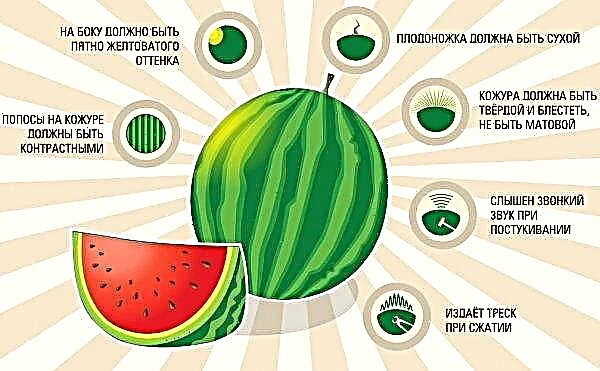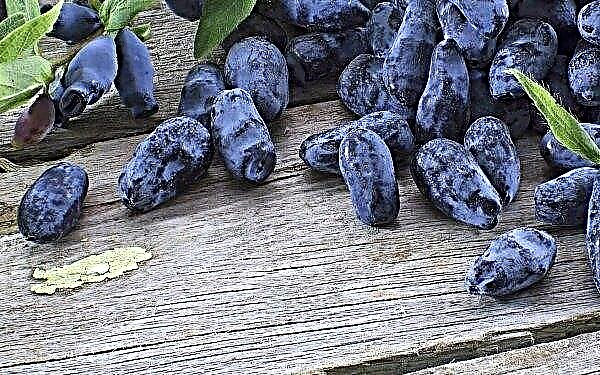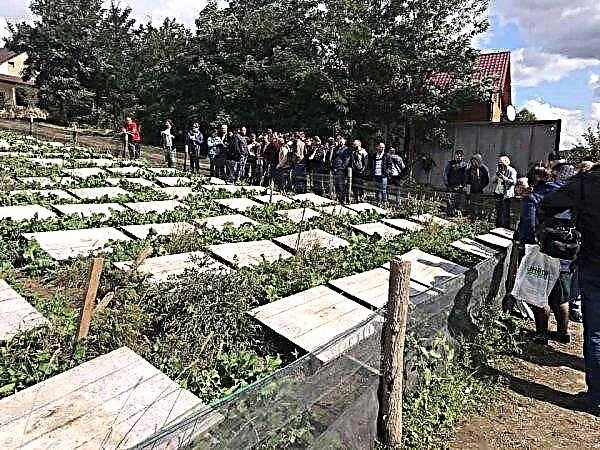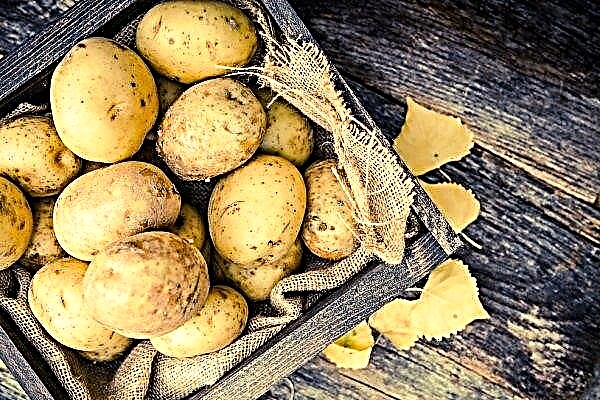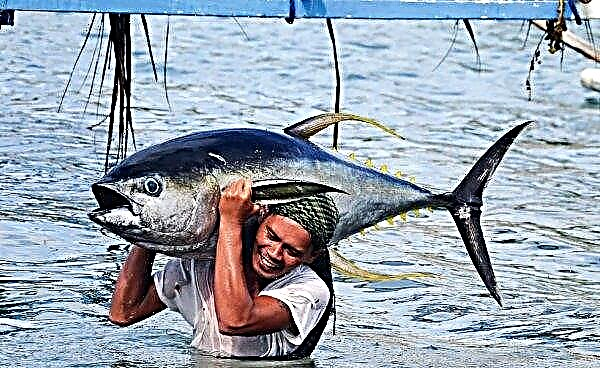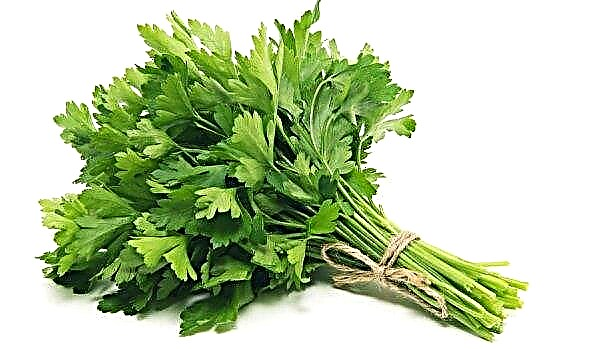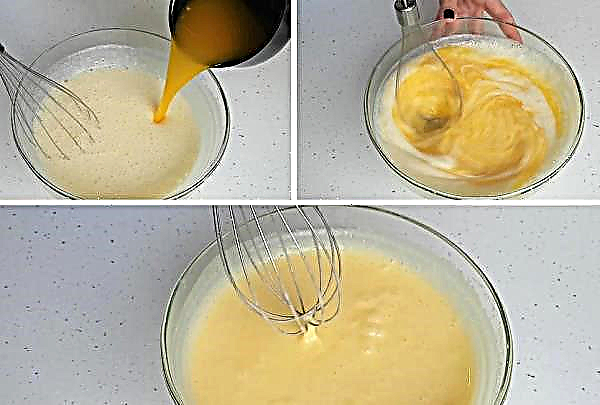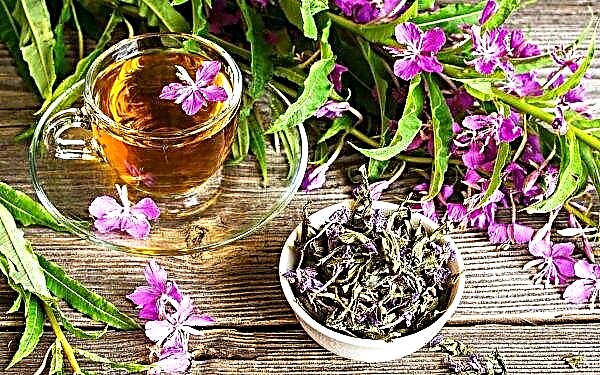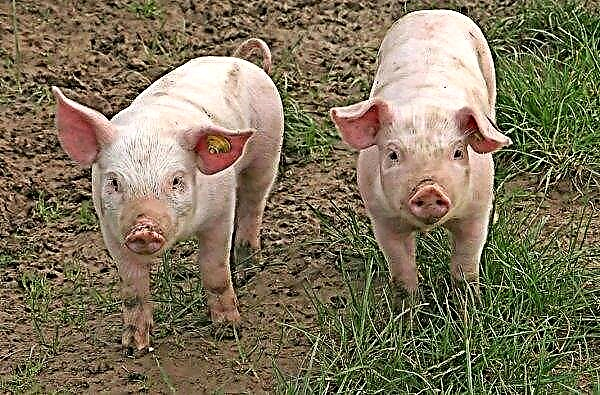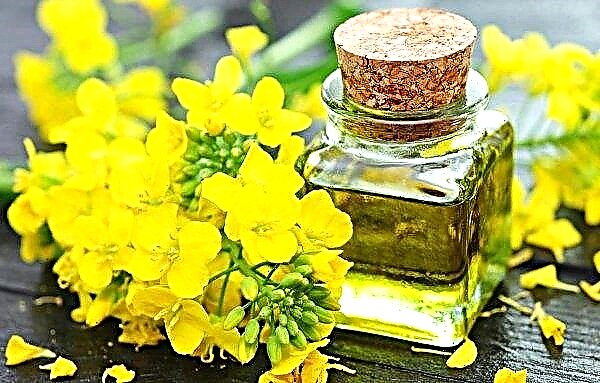In a huge variety of varieties and hybrids of cucumbers, a special place belongs to the fruits of the works of Dutch breeders. Such plants are always characterized by high productivity, good immunity to adverse weather conditions, diseases and pests, as well as excellent taste and marketability of the fruit. A striking example of such cucumbers is the Gunnar F1 hybrid, which will be discussed later.
Characteristic and Description
"Gunnar F1" (Gunnar) is an early ripe gherkin cucumber, bred in 2010 by the famous international company Enza Zaden. The company is headquartered in Enkhuizen (West Friesland, located in the north of Holland), and it has created wonderful hybrids and varieties of several dozen vegetables that have been successfully sold around the world for several decades.
Did you know? Enza Zaden specialists estimated that approximately 20 billion green lettuce bushes planted from the seeds of this brand are grown in the world every year.
Gunnar F1 appeared on the market of Eastern European countries, including Ukraine and Russia, in 2014 and immediately attracted the attention of professional farmers and ordinary summer residents. The manufacturer protects the information about which types of cucumbers were used to create this hybrid, but the breeders managed to create a culture that gives a very early and high yield of delicious fruits suitable for year-round cultivation under a film or in open ground - in spring, summer and autumn.
The morphological characteristics of the hybrid are as follows:
| Growth power | high |
| Internode | short |
| Leaves | dark green, large, powerful |
| Type of ovary | bouquet |
| Type of flowering | female (parthenocarpic) |
| The number of fruits in the bunch | 2–5 |
| Green color | dark green, plain, spikes light |
| The form and structure of Zelentsy | elongated, the number of tubercles is average, pubescence is strong, the skin is thin, very crispy |
| Sizes of greens | medium (length - up to 14 cm, thickness - up to 3.5 cm, weight - up to 120 g) |
| Harvest Market Percentage | 100% |
"Gunnar F1" is a parthenocarpic plant. This means that exclusively female flowers that do not require pollination are formed on the cucumber. The term "parthenocarpy" literally translates as "virgin fruit" (from the Greek "parthenos" - a virgin, and "karpos" - a fruit).
Important! In self-pollinated cucumbers, flowers have both a pestle and a stamen, that is, they are as if bisexual. Pollination is necessary for them, it just passes faster than in varieties with heterosexual flowers, while in parthenocarpic plants, fertilization is carried out without pollination.
Describing the technical characteristics of "Gunnar F1", it is worth noting the following important indicators:
| Ripening classification | ultra early |
| Possible crop yields per season | up to four |
| Taste characteristics of greens | sweet, juicy, with a bright honey aroma |
| Tasting score on a 5-point scale | 4,9 |
| Weather resistance | hardy, drought tolerant, can grow on saline soil |
| Resistance to cladosporiosis and powdery mildew | high |
| Resistance to cucumber mosaic, peronosporosis, yellowing | average |
Comparing the “Gunnar F1” with other popular hybrids, including Enza Zaden breeding, it should be noted that, according to most experts, it is superior to:
Pros and cons of the variety
- The advantages of the Dutch hybrid traditionally include:
- very early ripening;
- high productivity;
- good transportability;
- good performance indicators;
- universal purpose of the fruit;
- the possibility of growing both in the spring-summer and in the summer-autumn turnover;
- high resistance to many fungal infections;
- wide area of zoning;
- shade tolerance;
- resistance to adverse weather conditions;
- lack of need for pollinators;
- excellent taste;
- fruiting duration;
- lack of need for presowing treatment of seeds;
- high marketability - the fruits have the same size and almost absolute ripening, in case of over-ripening they do not “swell”.
- As the disadvantages of cucumber "Gunnar F1" is sometimes called:
- high cost of seeds;
- the impossibility of growing from seeds of their own crop (applies to all hybrids);
- frequent cases of defeat by peronosporosis (downy mildew);
- large-fruited (in comparison with other gherkins).
Optimal landing times
The timing of planting an early ripe hybrid depends on the region and the method of cultivation (in a greenhouse or in open ground, seedlings or seedlings).
It follows from the fact that:
- for the normal development of cucumber in the open ground, the temperature should not fall below + 12 ° C, and the ideal temperature regime for fruiting the crop is from + 25 ° to + 30 ° C during the day and about + 15 ... + 18 ° C at night;
- cucumbers grow much faster than most other crops, so seedlings must be planted no earlier than 3 weeks before the expected date of transplantation of the plant to a permanent place.
 Thus, in Ukraine and the southern regions of Russia, seedlings are grown around mid-April, and planting in open ground (seedlings or seeds) is made in early May. In areas with colder climates, these periods, respectively, are shifted by 2-3 weeks.
Thus, in Ukraine and the southern regions of Russia, seedlings are grown around mid-April, and planting in open ground (seedlings or seeds) is made in early May. In areas with colder climates, these periods, respectively, are shifted by 2-3 weeks.Did you know? The length of the largest cucumber in the world is 91.7 cm. Such a miracle was raised on his site by a Briton named Alfo Cobb. Interestingly, the previous world cucumber record - 89.2 cm - also belongs to this gardener.
Planting and growing varieties
Like other varieties and hybrids of cucumbers, “Gunnar F1” can be grown through seedlings or sown directly on the bed. Growing seedlings is more troublesome, but it allows you to get an earlier crop and protect the plant from the risk of suffering from unexpected spring frosts. In addition, after planting seedlings, the gardener gets the opportunity to see in advance how many bushes he has grown, and depending on this, he can plan the garden and support. Sowing seeds in open ground, you may encounter the need to plant too close growing specimens or, conversely, sowing seeds in places where seedlings did not appear. After weighing the pros and cons, everyone can choose the most convenient option for themselves.
Sowing seeds in open ground, you may encounter the need to plant too close growing specimens or, conversely, sowing seeds in places where seedlings did not appear. After weighing the pros and cons, everyone can choose the most convenient option for themselves.
Did you know? One of the most famous fans of cucumbers — Roman emperor Tiberius. It is believed that history owes him exactly the invention of greenhouses: in this way, subjects gave him the opportunity to feast on his favorite vegetable at any time of the year.
Seed directly into the ground
The seeds of the Dutch hybrid can be sown in open ground no earlier than the topsoil warms up to + 17 ° C. “Gunnar F1” is a shade-tolerant plant, however, to obtain a high yield it needs a sufficient amount of light, so it is advisable to choose an open area for the crop. Penumbra is permissible and even desirable in regions where summer is too hot, because delicate cucumber leaves are very prone to sunburn.
The plant has the following requirements for soil:
- friability and lightness (digging a bed under cucumbers, you can bring river sand into the ground);
- good breathability;
- high humidity in the absence of waterlogging;
- neutral acid-base balance (pH level not lower than 6.2);
- high percentage of humus and soil bacteria.
 It is best to prepare the bed for cucumbers in advance: in the early spring, they dig the soil, add organic and complex mineral fertilizers (nitrogen, potassium and phosphorus) to it, water it well and cover it with film. Before planting, remove the film and mark the beds so that 1 sq. m was located no more than three plants. Further, furrows 1–2 cm deep are dug in the ground, water is poured into them, then seeds are laid at the required distance and sprinkled with earth. Seedlings can be expected in a few days.
It is best to prepare the bed for cucumbers in advance: in the early spring, they dig the soil, add organic and complex mineral fertilizers (nitrogen, potassium and phosphorus) to it, water it well and cover it with film. Before planting, remove the film and mark the beds so that 1 sq. m was located no more than three plants. Further, furrows 1–2 cm deep are dug in the ground, water is poured into them, then seeds are laid at the required distance and sprinkled with earth. Seedlings can be expected in a few days.Important! Seeds of Dutch selection before planting do not need to pickle, stimulate, soak. Seeds are removed from the bag and put dry into the ground. This applies to both seedling and non-seedling cultivation methods.
Growing seedlings
Disposable cups or special cassettes with a capacity of at least 150 ml are best suited for growing cucumber seedlings, since this culture does not involve picking.
The soil mixture can be purchased at a specialized store or prepared independently by mixing:
- humus - 4 parts;
- sawdust - 1 part;
- peat - 1 part;
- nitrophosco - 1 tsp. on 3 l of substrate;
- wood ash - 1 tbsp. per 10 l of substrate.
 Prepared containers are filled with 2/3 of the moistened soil mixture. Next, spread 1 seed in the center and sprinkle with a 1 cm soil layer. For germination, the containers are placed in a well-lit, warm place: the optimum temperature values are + 22 ... + 25 ° C. Do not cover the cups with foil. After the emergence of seedlings, the room temperature should be gradually reduced to + 19 ... + 20 ° C and, as the soil dries, water it with warm, settled water. By the time the third true leaf appears, it is time to move the seedlings to a permanent place.
Prepared containers are filled with 2/3 of the moistened soil mixture. Next, spread 1 seed in the center and sprinkle with a 1 cm soil layer. For germination, the containers are placed in a well-lit, warm place: the optimum temperature values are + 22 ... + 25 ° C. Do not cover the cups with foil. After the emergence of seedlings, the room temperature should be gradually reduced to + 19 ... + 20 ° C and, as the soil dries, water it with warm, settled water. By the time the third true leaf appears, it is time to move the seedlings to a permanent place.Cucumber care after planting
Caring for the “Gunnar F1” hybrid is not particularly difficult and generally differs little from the technology for growing any other cucumbers, although there are still some nuances.
Watering and fertilizing
Gunnar F1 needs regular watering, but the amount of moisture in the soil should not be excessive. Cucumbers should be watered with a little warm water, carefully making sure that its drops do not remain on the leaves and stems in the daytime. It is best to provide a drip irrigation system for these purposes. Water consumption for each bush depends not only on weather conditions, but also on the growing season: during the period of plant development and its gain in green mass, watering can be moderate, but its volume should be increased from the moment of active fruiting. So, if during the first month after planting each plant should receive 1-2 liters of water for one irrigation, in the future its amount can be brought up to 3-4 liters if necessary. In addition, to provide the hybrid with the opportunity to show the yield indicators laid down by it by the manufacturer, the plant must be regularly fed.
So, if during the first month after planting each plant should receive 1-2 liters of water for one irrigation, in the future its amount can be brought up to 3-4 liters if necessary. In addition, to provide the hybrid with the opportunity to show the yield indicators laid down by it by the manufacturer, the plant must be regularly fed.
In total, fertilizers are applied 4–5 times during the season, namely:
- at the stage of formation of two pairs of real leaves in seedlings;
- 7-10 days after transplanting seedlings to a permanent place;
- at the time of pinching the growth point;
- at an early stage of fruiting;
- after the first wave of full fruiting.
Garter and bush formation
Unlike ordinary cucumbers, in which no more than two ovaries are formed in the nodes, bunch varieties and hybrids, to which Gunnar F1 belongs, are always formed into one stalk. The correct formation of the bush also involves the procedure of "blinding" - this is the removal of all shoots and ovaries that were formed at a height of 5-8 internodes from the ground. All other ovaries forming above leave, and shoots, if they appear, are removed. The growth point is pinched at a height of 3-5 sheets. To garter a hybrid, it is best to use a mesh by twisting the stem around its cells and directing it upward. The height of such a structure when growing cucumber in open ground can be about 2 meters or slightly higher, for greenhouse plants it is determined by the size of the greenhouse. Lower leaves are recommended to be removed as they dry. It is better to do this in the morning or evening - so the plant will experience less stress.
To garter a hybrid, it is best to use a mesh by twisting the stem around its cells and directing it upward. The height of such a structure when growing cucumber in open ground can be about 2 meters or slightly higher, for greenhouse plants it is determined by the size of the greenhouse. Lower leaves are recommended to be removed as they dry. It is better to do this in the morning or evening - so the plant will experience less stress.
Important! The less sunlight the bush receives, the more sinuses from below it is necessary to clear.
Soil care
After each rain and watering, the soil on the beds must be loosened, otherwise it begins to become covered with cracks, through which a large amount of moisture evaporates. An important condition for maintaining a healthy bush is also the regular removal of weeds, since they draw nutrients from the soil and are often the reserve of fungal infections and pest larvae. Both tasks - loosening and weeding - are solved by mulching, that is, sheltering the soil around the bush with a thick layer of straw, peat or sawdust.
Disease and pest resistance
All varieties and hybrids of Enza Zaden are highly resistant to diseases and pests, and Gunnar F1 is no exception. Nevertheless, in order to prevent infection of plants with downy mildew and other fungal infections, experts recommend that the bed is treated with systemic or contact fungicides before active fruiting, such as:
- "Ridomil Gold";
- "Infinito";
- Alirin-B;
- Thanos.
Important! When using drip irrigation, the irrigation tape is placed on top of a layer of mulch, and not under it.
The same drugs can also be used for treatment - in the event that signs of damage to the cucumber are still recorded. However, it is much more environmentally friendly and safer to use biological agents to fight infections and pests. They are not toxic and allow you to safely eat fruits taken on the second day after treatment.
The following brands can be cited as examples of such preparations:
- Fitosporin-M;
- "Haupsin";
- Mikosan
- "Gamair";
- "Integral";
- Planriz.
 As for pests, Gunnar F1 can be attacked by a spider mite, sprout fly or gourd aphids. To combat these parasites in the initial stages of the defeat, you can resort to using folk remedies, such as tobacco infusion or ordinary soap solution.
As for pests, Gunnar F1 can be attacked by a spider mite, sprout fly or gourd aphids. To combat these parasites in the initial stages of the defeat, you can resort to using folk remedies, such as tobacco infusion or ordinary soap solution.If the measures taken have not yielded results, insecticidal and acaricidal preparations are used, in particular:
- "Chloride";
- "Actellicus";
- Angio
- "Northwind";
- "Coragen" and others.
Did you know? Cucumbers were first cultivated by the Indians, and there are the first time they began in Mesopotamia. Scientists believe that this vegetable is in the diet of people for about four and a half thousand years.
Harvesting, storage and consumption
With proper agricultural technology, the harvesting of Gunnar F1 can be harvested as early as a month after planting. The first cucumbers are recommended to be removed from the bush a little earlier than they reach their maximum size - this stimulates the formation of new fruits and reduces the load on the young plant. To obtain maximum yields on the bush, it is recommended to leave 3 to 5 greens at the same time in the ripening stage. With this technique, the fruits ripen once every 2-3 days, and if weather conditions and soil conditions allow, then every day. Despite the fact that the “Gunnar F1” cucumbers are considered universal, in practice they are primarily used for fresh consumption - whole or in salads. The remarkable taste qualities of gherkins, the lack of bitterness in them, a uniform juicy pulp without voids and the presence of a pleasant crunch when cracking contribute to this a lot.All these properties make such cucumbers very attractive for pickling and pickling, but it is more rational to use later varieties for these purposes, which are much cheaper.
Despite the fact that the “Gunnar F1” cucumbers are considered universal, in practice they are primarily used for fresh consumption - whole or in salads. The remarkable taste qualities of gherkins, the lack of bitterness in them, a uniform juicy pulp without voids and the presence of a pleasant crunch when cracking contribute to this a lot.All these properties make such cucumbers very attractive for pickling and pickling, but it is more rational to use later varieties for these purposes, which are much cheaper.
Important! It is better to collect cucumbers in the early morning or late evening: at this time they contain the maximum amount of moisture, due to which they are especially elastic and crunch more.
It is advisable to consume fresh and preserve cucumbers as soon as possible after collecting them. Despite the fact that the creators of “Gunnar F1” tried to achieve maximum shelf life of fruits, every day this vegetable loses a significant amount of nutrients and taste. You should also not leave greenery on the bush: in this case, the cucumbers very quickly outgrow the prescribed sizes and become less attractive, in addition, the overall productivity indicators sharply decrease due to the slowdown in the growth of other fruits. The Dutch hybrid Gunnar F1 can rightfully be called universal. It is perfect for both personal homestead and large-scale farming, it can be grown in greenhouses and in the open field, always giving an early and stable harvest of juicy, sweet, fragrant cucumbers with excellent commodity characteristics.
The Dutch hybrid Gunnar F1 can rightfully be called universal. It is perfect for both personal homestead and large-scale farming, it can be grown in greenhouses and in the open field, always giving an early and stable harvest of juicy, sweet, fragrant cucumbers with excellent commodity characteristics.

